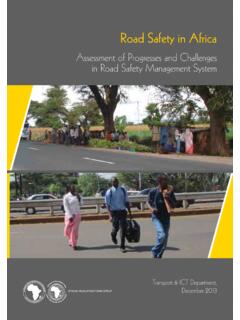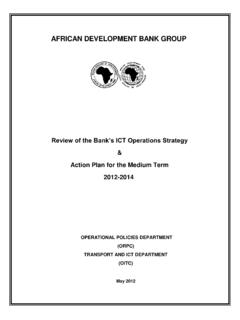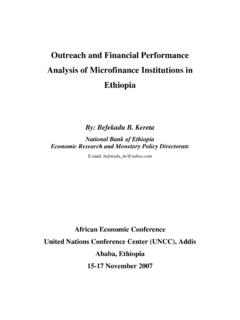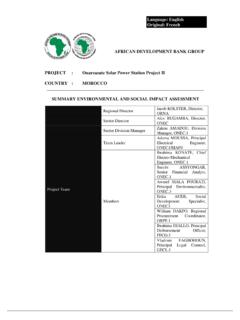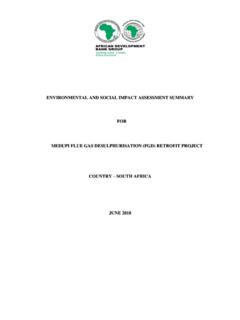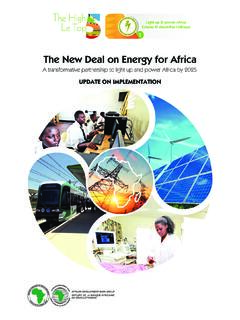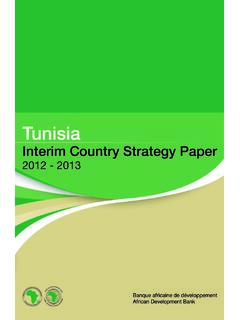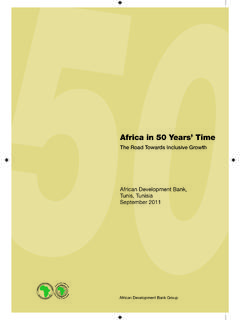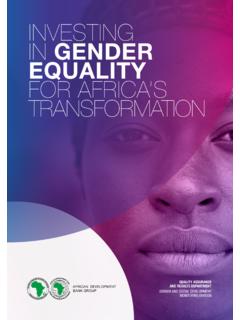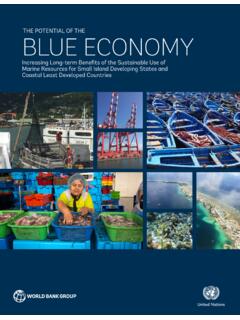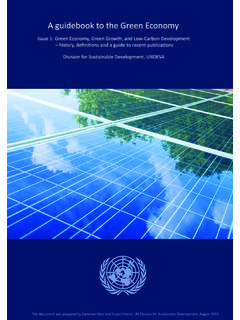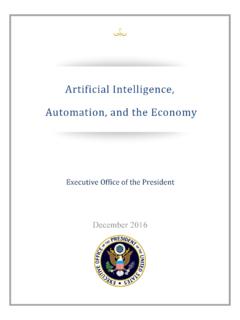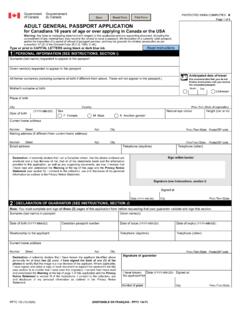Transcription of Fisheries and Aquaculture in the Context of Blue Economy
1 BACKGROUND PAPER Fisheries and Aquaculture in the Context of blue Economy Author: Lahsen Ababouch, FAO FIPI Co-conveners: Cheryl Carolu, WWF i Abstract Ocean and inland waters (seas, lakes, rivers and reservoirs) provide significant benefits to humanity, encompassing i) food and nutrition security from Fisheries and Aquaculture , ii) economic and social development from Fisheries and Aquaculture , marine and coastal tourism, shipping, mining, energy and iii) ecosystem services such as carbon sequestration, water filtration, atmospheric and temperature regulation, protection from erosion and extreme weather events. However, the asset base of oceans and inland waters has been eroding rapidly because of over-fishing, pollution from land-based sources, mangrove deforestation, climate change and ocean acidification. Hence, realizing the full potential of the oceans and inland waters requires a paradigm shift to embrace a new, responsible and sustainable approach that is more environmentally, socially and economically effective.
2 This comes at a crucial time when the need for food and resources from the ocean is increasing rapidly to meet the needs of the growing population. There is a wide consensus that blue Economy / blue Growth can fulfil the requirements for such an approach. This has been debated in various fora and adopted by several institutions such as OECD, UNEP and FAO to cite a few. It featured prominently during Rio+20, whose outcomes have proven to be a strong catalyst for driving new efforts towards the implementation of previous and new commitments on oceans and inland waters to restore, exploit and conserve aquatic resources. Rio + 20 focused on two key themes: to further the development and refinement of the institutional framework for sustainable development and the advancement of the Green Economy Concept. This concept was framed in the Context of sustainable development and poverty eradication1. Since then, this concept has been at the center of key international consultations which in turn resulted in important commitments such as in the Hague Declaration Netherlands, 2014), the Djakarta Compass (Indonesia, 2014) or the recent Our Oceans Conference (Chile, 2015).
3 The scope of blue Economy / blue Growth can vary depending on the sectors considered. Economic sectors using oceans and inland waters include Fisheries , Aquaculture , tourism, shipping, biotechnologies, maritime security, mining, oil and gas, renewable energy. These various sectors and their carbon footprint have a direct impact on the aquatic eco-systems and the fauna and flora they sustain. The aim of an overarching blue Economy / blue Growth strategy is to assess ways and means to mitigate the cumulative impact of these economic sectors on the living aquatic resources, biodiversity and eco-system services. In several coastal developing countries, including Small Island Developing States (SIDS), blue Economy / blue Growth strategies have been adopted to promote at the initial stages food security and decent livelihoods. They initially include Fisheries , Aquaculture , eco-system services, marine and coastal tourism and aim at gradually integrating other important sectors depending on the Context .
4 This paper looks at the current situation of Fisheries and Aquaculture in the Context of the blue Economy / blue Growth and its relevance for African costal countries. It describes the current status 1 Rio + 20, 2012. The Future We Want, Paragraph 56. ii of thinking and action plans for blue Economy / blue Growth, in particular for sustainable Fisheries and Aquaculture , with sufficient details on FAO s approach and interventions. It will be enriched soon by experiences from other organizations concerned with Fisheries and Aquaculture development in Africa. 1 1. BACKGROUND The opportunity Ocean and inland waters (lakes, rivers and reservoirs) provide significant benefits to humanity, encompassing i) food and nutrition security from Fisheries and Aquaculture , ii) economic and social development from Fisheries and Aquaculture , marine and coastal tourism, shipping, mining, energy and iii) ecosystem services such as carbon sequestration, water filtration, atmospheric and temperature regulation, protection from erosion and extreme weather events.
5 Fisheries and Aquaculture supply 17 percent of global animal proteins and support livelihoods of about 660 820 million livelihoods (or 10 12 percent of the world s population). Currently 3 billion people depend on fish for twenty percent of their average per capita intake of animal protein. It is greater for the Low Income Food Deficit Countries (LIFDCs) and much greater for the population of many SIDS. More than 40 percent of the global population lives within 100 kilometers of the coast. Thirteen of the world s 20 mega-cities lie along coasts. Nearly 700 million people live in low-lying coastal areas less than 10 meters above sea level. Over 90 percent of the livelihoods that are directly dependent on Fisheries and Aquaculture occur in developing countries, mostly in small-scale operations. Marine ecosystem services have substantial economic value. While exact figures are still debated, the estimated figures are in the order of trillions of US dollars annually.
6 Nearly three-quarters of this value resides in coastal zones. These ecosystem services offer a renewable opportunity to meet basic human needs, support a healthy and sustainable Economy , and provide jobs for a growing global population. Aquatic ecosystems act as important reservoirs for inorganic carbon with the oceans storing roughly 50 times more carbon dioxide (CO2) than the atmosphere; ecosystems such as mangroves, seagrasses, and inland waters are among the most efficient ecosystems in sequestering CO2 in the form of blue carbon sinks. They can sequester up to five times the amounts of carbon absorbed by tropical forests and function as important nursery, feeding and reproduction areas for many species. In addition, mangrove forests provide natural protection against storms and erosion for coastal communities and breeding grounds for many aquatic species. Almost 80 percent of global trade in goods is transported by sea. Coastal tourism is a key engine of economic growth for many coastal countries, in particular in the SIDS.
7 Ocean revenues include some US$ 161 billion annually from marine and coastal tourism, in addition to a growing range of products such as antibiotics, antifreeze, antifouling paints. Experts predict that ocean energy, which is still in its early stages of development, could be key for meeting the world s energy demands, including with aquatic biofuels and renewable energies. 2 The threats One of the biggest challenges of the 21st century is food and nutrition security: how to feed a population expected to reach billion people by 2050 in the face of climate change, economic and financial uncertainty and the growing competition for natural resources. Unfortunately, the asset base of oceans and inland waters has been eroding rapidly because of over-fishing, pollution from land-based sources, mangrove deforestation, climate change, increase in hypoxic areas or dead zones , expansion of invasive species and ocean acidification.
8 Mangroves have been reduced to 30 to 50 percent of their historical cover. Over 80 percent of the 232 marine eco-regions reported the presence of invasive species which is the second most significant cause of biodiversity loss on a global scale. The multiple challenges of food insecurity and malnutrition, climate change, degradation of ecosystems, and economic recession require an integrated response and an urgent transition of the world Economy towards a sustainable, inclusive and resource efficient path. 2. blue Economy / blue GROWTH There is a wide consensus that blue Economy / blue Growth can fulfil the requirements for such an approach. The first proposal for a blue Economy is generally attributed to Gunter Pauli in his book The blue Economy 10 years 100 innovations 100 million jobs (2010). Interestingly the concept was not initially intended to relate specifically to oceans or inland waters, rather the term blue Economy was used to reflect an evolution and refinement of the green Economy concept2.
9 The concept of blue Economy , which has been referred to also as, blue Green Economy or blue Growth, the new maritime Green Economy (EU, 2011) , Green Economy in a blue World (UNEP, 2012) , blue Growth (FAO, 2013) or Green Growth in Fisheries and Aquaculture (OECD, 2014) has developed during recent years as an emerging paradigm for the sustainable management of natural marine and freshwater resources. The proponents of the blue Growth prefer this terminology instead of blue Economy , to emphasize the need for growth, because there has been criticism in some development circles of the green Economy concept, in particular its early emphasis on conservation and environmental protection at the cost of economic growth and social development. The blue Economy / blue Growth concept featured prominently during Rio+20 and its high profile Oceans Day. The outcomes of Rio+20 have proven to be a strong catalyst for driving new efforts towards the implementation of previous and new commitments on oceans and inland waters to restore, exploit and conserve aquatic resources.
10 It is gaining even further visibility and importance within the framework of the post-2015 Sustainable Development Goals (SDGs), in particular, Goal 2 (end hunger, achieve food security and improved nutrition, and promote sustainable agriculture) and Goal 14 (conserve and sustainably use the oceans, seas and marine resources for sustainable development). 2 3 Since Rio +20, this concept has been at the center of international consultations, including the: - Asia Conference on Oceans, Food Security and blue Growth (18 21 June 2013, Bali, Indonesia) , - the First blue Economy Summit (19 20 January, Abu Dhabi, United Arab Emirates) , - the Global Oceans Action Summit for Food Security and blue Growth (22 25 April 2014, The Hague, Netherlands) , - the John Kerry s Our Ocean Conference (16 17 June 2014), - the UN Conference on SIDS (1 4 September 2014, Apia, Samoa) , - the Workshop for the Development of a Voluntary Global Alliance/Network for Actions on blue Growth and Food Security (8 9 September 2014, Jakarta, Indonesia) , - the Strategy Meeting for Action on blue Growth and Food Security (11 13 March 2015, St George s, Grenada) , - The World Ocean Summit (Cascais, Portugal, 3-5 June 2015), - The 2nd Our Ocean Conference, Valparaiso, Chile 5-6 October 2015).
